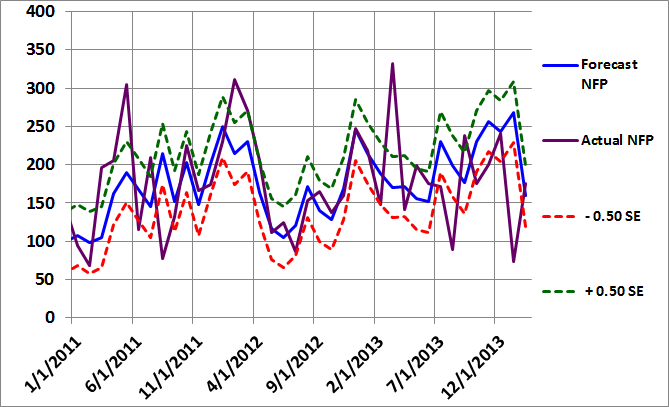This article presents the Trader Edge aggregate neural network model forecast for the January 2014 non-farm payroll data, which is scheduled to be released tomorrow morning at 8:30 AM EST.
Non-Farm Payroll (NFP) Model Forecast - January 2014
The Trader Edge aggregate NFP model represents the average of three neural network forecasting models, each of which employs a different neural network architecture. Unlike expert systems, neural networks use algorithms to identify and quantify complex relationships between variables based on historical data. All three models derive their forecasts from seven explanatory variables and the changes in those variables over time.
The table in Figure 1 below includes the monthly non-farm payroll data for two months: December 2013 and January 2014. The December data was released last month and the non-farm payroll data for January 2014 will be released tomorrow morning at 8:30 AM EST.
The model forecasts are in the third data row of the table (in blue). Note that past and current forecasts reflect the latest values of the independent variables, which means that forecasts will change when revisions are made to the historical economic data.
The monthly standard error of the model is approximately 79,700 jobs. The first and last data rows of the table report the forecast plus 0.5 standard errors (in green) and the forecast minus 0.5 standard errors (in red), respectively. All values are rounded to the nearest thousand. If the model errors were normally distributed, roughly 31% of the observations would fall below -0.5 standard errors and another 31% of the observations would exceed +0.5 standard errors.
The actual non-farm payroll release for December 2013 is in the second data row of the table (in purple). The consensus estimate (reported by Briefing.com) for January 2014 is also in the second data row of the table (in purple). The reported and consensus NFP values also include the deviation from the forecast NFP (as a multiple of the standard error of the estimate). Finally, the last column of the table includes the estimated changes from December 2013 to January 2014.
Model Commentary
The aggregate model forecast for January is 159,000, which is down 110,000 jobs from last month's revised forecast of 269,000. The Briefing.com consensus estimate for January is 175,000, which is 101,000 higher than the December NFP release. The actual December data was sharply below the revised December forecast (-2.45 S.E.) and the consensus estimate for January is modestly above the model forecast (+0.20 S.E.).
The NFP forecast this month is especially problematic. The actual NFP jobs data in December of 74,000 was almost 2.5 standard errors below the December estimate. This is highly unusual. Actual data that far below the forecast means that the NFP data in December was completely inconsistent with the data from all of the explanatory variables. As I have mentioned many times, the NFP data is notoriously inaccurate from month to month. December could have been another example of a monthly data anomaly. If not, the employment market has weakened dramatically.
The model is forecasting a significant decline in the NFP data from December to January (-110,000 jobs). However, one major reason for the sharply lower forecast in January is the questionable data point of 74,000 in December. In other words, the model uses past NFP data as one component of its current forecast. If the past data is bad, then it would also adversely affect the quality of the current forecast. This is one of the reasons that I calculate the average of three different neural network model forecasts. Not surprisingly, there is substantial disagreement among the three neural network models this month.
Finally, the recent winter storms add another layer of uncertainty to the NFP data tomorrow. If the winter storms affected the January data in any way, this effect would not be reflected in the model forecast. Given the recent pullback in the equity markets, the market will be looking for some clarity tomorrow. Unfortunately, given the issues outlined above, the range of possible values for the January 2014 NFP data will be much wider than usual.
Given the data anomaly in December and the recent winter weather conditions, it may take another month or two until we can a clearer picture of the strength of the employment market.
Summary
Basic forecasting tools can help you identify unusual consensus economic estimates, which often lead to substantial surprises and market movements. Identifying such environments in advance may help you protect your portfolio from these corrections and help you determine the optimal entry and exit points for your strategies.
In the case of the NFP data, the monthly report is notoriously unreliable and prone to substantial revisions. As a result, having an independent and unbiased indicator of the health of the U.S. job market is especially important.
Trader Edge Strategy E-Subscription Now Available: 20% ROR
The Trader Edge Asset Allocation Rotational (AAR) Strategy is a conservative, long-only, asset allocation strategy that rotates monthly among five large asset classes. The AAR strategy has generated 20%+ annual returns over the 20+ year combined back and forward test period. Please use the above link to learn more about the AAR strategy.
Feedback
Your comments, feedback, and questions are always welcome and appreciated. Please use the comment section at the bottom of this page or send me an email.
Referrals
If you found the information on www.TraderEdge.Net helpful, please pass along the link to your friends and colleagues or share the link with your social or professional networks.
The "Share / Save" button below contains links to all major social and professional networks. If you do not see your network listed, use the down-arrow to access the entire list of networking sites.
Thank you for your support.
Brian Johnson
Copyright 2014 - Trading Insights, LLC - All Rights Reserved.














